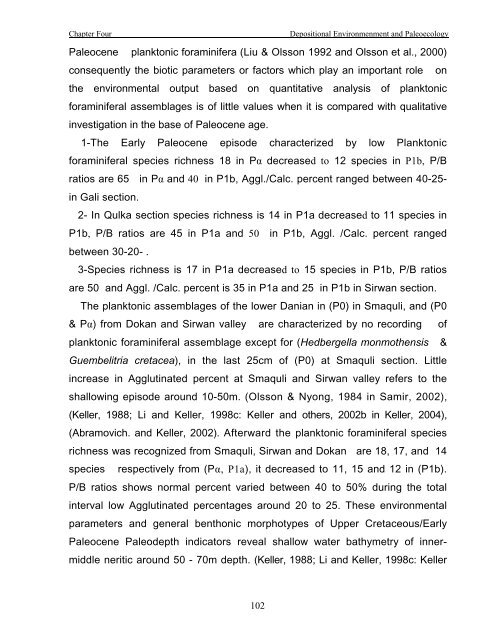biostratigraphy and paleoecology of cretaceous/tertiary boundary in ...
biostratigraphy and paleoecology of cretaceous/tertiary boundary in ...
biostratigraphy and paleoecology of cretaceous/tertiary boundary in ...
Create successful ePaper yourself
Turn your PDF publications into a flip-book with our unique Google optimized e-Paper software.
Chapter Four<br />
Depositional Environmenment <strong>and</strong> Paleoecology<br />
Paleocene planktonic foram<strong>in</strong>ifera (Liu & Olsson 1992 <strong>and</strong> Olsson et al., 2000)<br />
consequently the biotic parameters or factors which play an important role on<br />
the environmental output based on quantitative analysis <strong>of</strong> planktonic<br />
foram<strong>in</strong>iferal assemblages is <strong>of</strong> little values when it is compared with qualitative<br />
<strong>in</strong>vestigation <strong>in</strong> the base <strong>of</strong> Paleocene age.<br />
1-The Early Paleocene episode characterized by low Planktonic<br />
foram<strong>in</strong>iferal species richness 18 <strong>in</strong> Pá decreased to 12 species <strong>in</strong> P1b, P/B<br />
ratios are 65 <strong>in</strong> Pá <strong>and</strong> 40 <strong>in</strong> P1b, Aggl./Calc. percent ranged between 40-25-<br />
<strong>in</strong> Gali section.<br />
2- In Qulka section species richness is 14 <strong>in</strong> P1a decreased to 11 species <strong>in</strong><br />
P1b, P/B ratios are 45 <strong>in</strong> P1a <strong>and</strong> 50 <strong>in</strong> P1b, Aggl. /Calc. percent ranged<br />
between 30-20- .<br />
3-Species richness is 17 <strong>in</strong> P1a decreased to 15 species <strong>in</strong> P1b, P/B ratios<br />
are 50 <strong>and</strong> Aggl. /Calc. percent is 35 <strong>in</strong> P1a <strong>and</strong> 25 <strong>in</strong> P1b <strong>in</strong> Sirwan section.<br />
The planktonic assemblages <strong>of</strong> the lower Danian <strong>in</strong> (P0) <strong>in</strong> Smaquli, <strong>and</strong> (P0<br />
& Pá) from Dokan <strong>and</strong> Sirwan valley are characterized by no record<strong>in</strong>g <strong>of</strong><br />
planktonic foram<strong>in</strong>iferal assemblage except for (Hedbergella monmothensis &<br />
Guembelitria cretacea), <strong>in</strong> the last 25cm <strong>of</strong> (P0) at Smaquli section. Little<br />
<strong>in</strong>crease <strong>in</strong> Agglut<strong>in</strong>ated percent at Smaquli <strong>and</strong> Sirwan valley refers to the<br />
shallow<strong>in</strong>g episode around 10-50m. (Olsson & Nyong, 1984 <strong>in</strong> Samir, 2002),<br />
(Keller, 1988; Li <strong>and</strong> Keller, 1998c: Keller <strong>and</strong> others, 2002b <strong>in</strong> Keller, 2004),<br />
(Abramovich. <strong>and</strong> Keller, 2002). Afterward the planktonic foram<strong>in</strong>iferal species<br />
richness was recognized from Smaquli, Sirwan <strong>and</strong> Dokan are 18, 17, <strong>and</strong> 14<br />
species respectively from (Pá, P1a), it decreased to 11, 15 <strong>and</strong> 12 <strong>in</strong> (P1b).<br />
P/B ratios shows normal percent varied between 40 to 50% dur<strong>in</strong>g the total<br />
<strong>in</strong>terval low Agglut<strong>in</strong>ated percentages around 20 to 25. These environmental<br />
parameters <strong>and</strong> general benthonic morphotypes <strong>of</strong> Upper Cretaceous/Early<br />
Paleocene Paleodepth <strong>in</strong>dicators reveal shallow water bathymetry <strong>of</strong> <strong>in</strong>nermiddle<br />
neritic around 50 - 70m depth. (Keller, 1988; Li <strong>and</strong> Keller, 1998c: Keller<br />
102

















